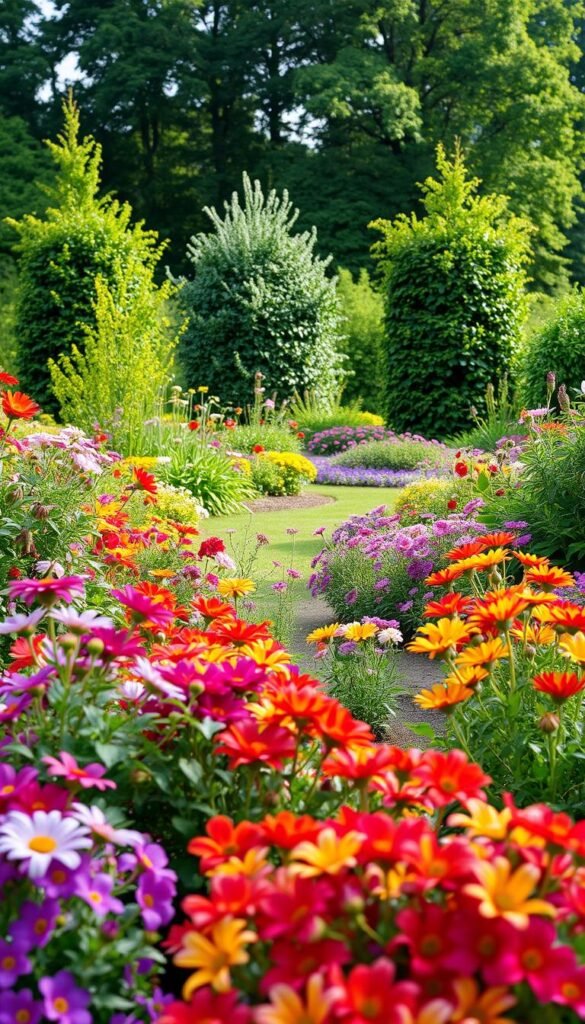Transforming your yard into a vibrant oasis starts with simple yet powerful concepts. Whether working with sprawling lawns or compact urban spaces, thoughtful arrangements turn ordinary areas into eye-catching displays. Discover how flower garden design principles used by experts can help you craft spaces that thrive in your local climate.
Successful layouts begin with observing nature’s patterns. Grouping plants in clusters of odd numbers creates visual harmony, while repeating color schemes ties everything together. This approach works equally well for cottage-style beds or modern minimalist arrangements.
Your local environment plays a crucial role in plant selection. Drought-resistant varieties might shine in arid regions, while shade-loving specimens could transform that tricky corner under your oak tree. Remember: thriving plants always look more polished than struggling ones.
Maintenance becomes easier when you focus on strategic placement. Position taller specimens at the back of borders and consider bloom times to ensure continuous color. With these fundamentals in place, even novice growers can cultivate spaces that neighbors will admire.
Understanding the Vision for Your Home Flower Garden Inspiration: Achieving Professional-Looking Results
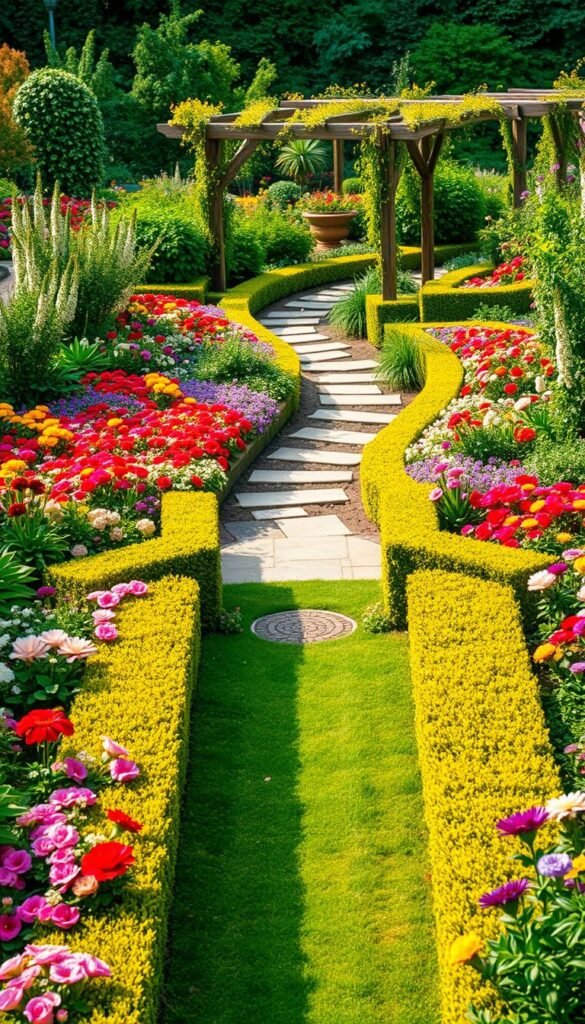
Crafting your outdoor space begins with a clear vision that blends personal taste with practical planning. Whether drawn to wildflower charm or geometric precision, your chosen aesthetic becomes the blueprint for every decision ahead.
Defining Your Personal Landscape Character
Three distinct approaches dominate residential spaces:
| Style | Key Features | Typical Plants | Cost Range |
|---|---|---|---|
| Cottage | Layered textures, mixed edibles/ornamentals | Roses, lavender, hollyhocks | $800-$3,000 |
| Formal | Boxwood hedges, repeating patterns | Hydrangeas, tulips, hostas | $1,500-$5,000+ |
| Modern | Minimalist groupings, architectural plants | Ornamental grasses, succulents | $1,000-$4,000 |
“Your space should whisper your personality before guests reach the front door,” notes landscape designer Mara Whittaker. This philosophy applies whether you’re planting cascading sweet peas along a picket fence or installing geometric succulent arrangements.
Balancing Dreams With Practical Reality
Smart planning accounts for both immediate costs and long-term care. A 100-square-foot bed might need:
- $200-$700 for soil preparation
- $300-$1,200 for starter plants
- $50/month average maintenance
Consider phased installations for larger projects. Pair structural evergreens with seasonal blooms for instant impact while slower-growing specimens mature. For creative layout patterns that maximize visual interest, draw inspiration from nature’s irregular rhythms rather than rigid grids.
Exploring Garden Design Ideas from Around the United States
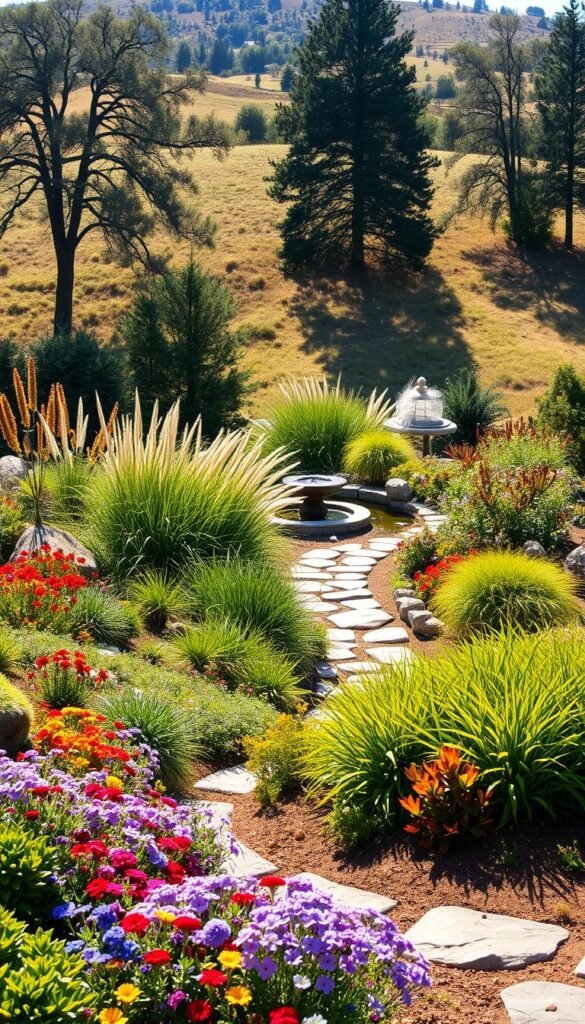
America’s diverse landscapes inspire unique approaches to cultivating stunning outdoor spaces. From rainy coastal zones to arid inland regions, understanding your environment unlocks creative solutions that feel both intentional and effortless.
Regional Garden Trends and Visual Inspirations
Coastal New England gardens burst with hydrangeas and daylilies, while Texas landscapes glow with drought-tolerant lantana. “Your location isn’t a limitation—it’s a design catalyst,” explains Portland-based horticulturist Lila Chen. Midwestern plots thrive with native coneflowers and black-eyed Susans that withstand temperature swings.
Recent trends show Northeastern gardeners embracing stone pathways mimicking Appalachian trails. Southern designers mix camellias with pollinator-friendly natives like milkweed. These adaptations prove climate-conscious choices can be visually striking.
Using Local Climate and Soil to Your Advantage
Test your soil’s pH and texture before planting. Sandy Arizona earth loves agaves, while clay-rich Southern dirt suits magnolias. Adjust watering schedules to match rainfall patterns—succulents in California need less attention than Seattle’s fern collections.
Create Mediterranean vibes anywhere using lavender (thrives in zones 5-9) paired with gravel mulch. For desert aesthetics, try yucca plants in well-draining soil. Local extension offices offer free guides matching plants to your area’s conditions.
Creative Layouts: From Flower Beds to Raised and Rock Gardens
Elevate your outdoor space’s personality through innovative planting arrangements that blend form and function. Thoughtful layouts turn basic plantings into dynamic compositions, whether you’re working with sprawling yards or cozy corners.
Types of Flower Beds: Raised, Border, and Island Designs
Raised beds solve multiple challenges at once. They improve drainage in clay-heavy soils and let you customize growing conditions for fussy plants. Landscape designer Mara Whittaker suggests: “Use cedar boards for natural rot resistance or painted metal for contemporary flair—both options outlast traditional wood.”
Border beds create crisp edges along walkways or property lines. Try alternating lavender and catmint for fragrant definition. Island beds become living sculptures when surrounded by contrasting materials like white gravel or black mulch.
Incorporating Rock Elements for Visual Interest
Rock gardens bring mountainscapes to flat yards. Arrange boulders first, then fill gaps with creeping phlox or hens-and-chicks. Pro tip: Bury stones partially to mimic natural erosion patterns. River rock mulch around succulents reduces watering needs while preventing weeds.
Combine different rock sizes for depth—large stones anchor spaces, while pebble streams guide the eye. Pair these features with drought-tolerant yarrow or sedum for textures that shine in every season. Remember to leave room for plants to spread without overcrowding.
Enhancing Your Garden with Unique Design Features
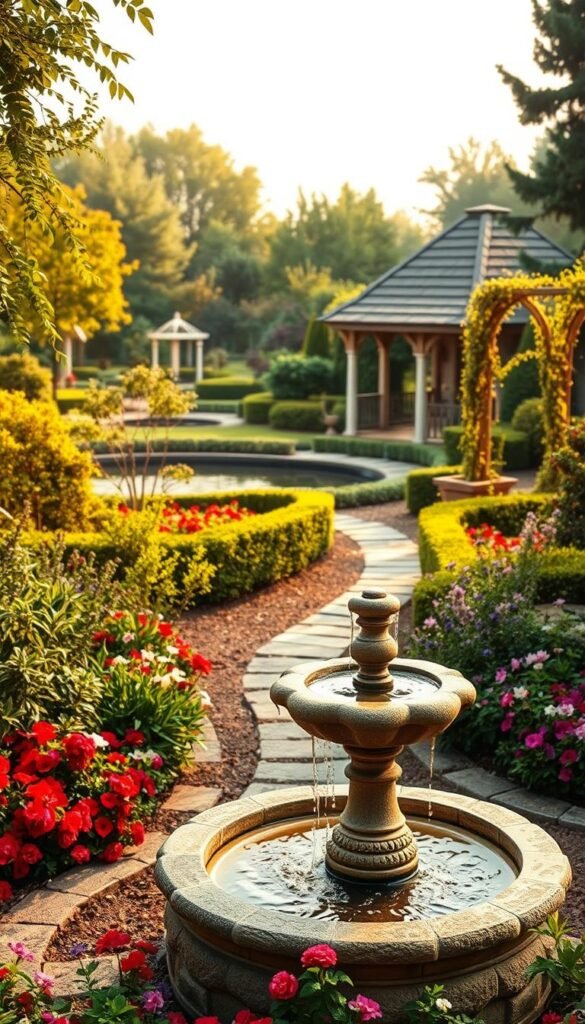
Elevate your outdoor experience by blending functional elements with artistic touches. Strategic additions transform ordinary plots into immersive retreats that engage all senses while solving practical challenges.
Integrating Water Features and Lighting Effects
A solar-powered fountain creates instant tranquility without complex plumbing. For smaller spaces, try wall-mounted cascades or birdbaths that double as visual interest points. “Moving water attracts wildlife while masking urban noise,” observes designer Carla Simmons.
Pathway lights with warm LEDs extend evening enjoyment safely. Highlight specimen trees with uplighting or string fairy lights through pergolas. These elements work best when layered – combine subtle ground lights with dramatic focal points.
Using Color Theory for Striking Plant Arrangements
Complementary hues like purple salvia paired with yellow coreopsis create vibrant contrasts. For serene color schemes, blend analogous shades – think pink peonies fading into lavender irises. This approach works wonders in flower garden layouts where seasonal changes matter.
Implementing Vertical Garden Ideas for Small Spaces
Maximize tight areas with tiered planters holding trailing petunias or strawberries. Trellises support climbing roses or clematis, adding height without footprint expansion. For urban balconies, try pocket wall systems with herbs and compact blooms like colorful container arrangements.
Group vertical elements near seating areas to create intimate green screens. Pair tall ornamental grasses with mid-height dahlias and creeping thyme for layered texture that fools the eye into perceiving depth.
Professional Tips for Plant Selection and Layout Strategies
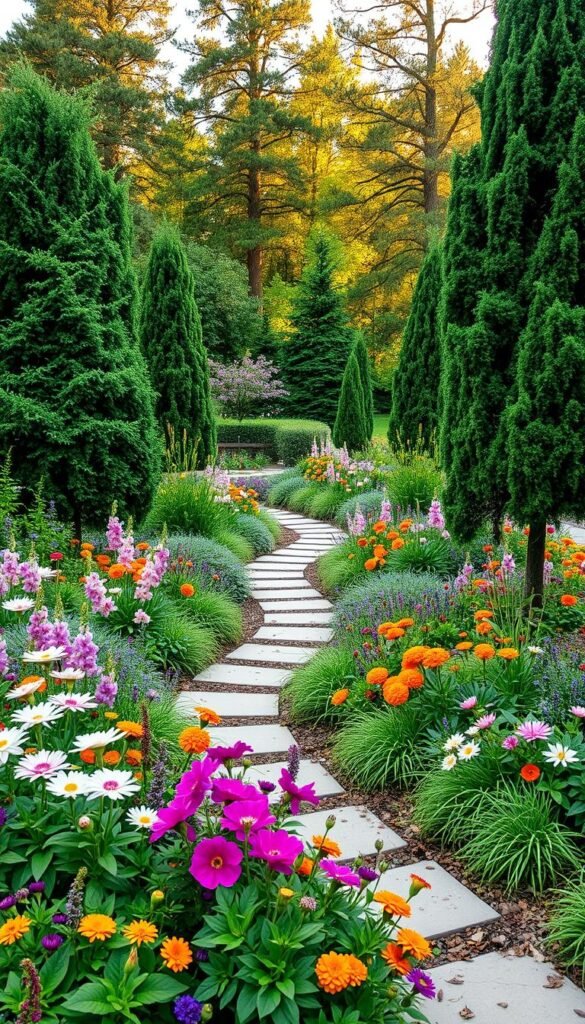
Mastering plant combinations transforms your landscape into a living tapestry that evolves through seasons. Smart pairings balance lasting structure with seasonal surprises, creating dynamic displays that feel intentional yet effortless.
Mixing Annuals and Perennials for Continuous Bloom
Pair long-lasting perennials like coneflowers with vibrant annuals such as zinnias. This combo ensures color from spring frost to autumn’s first chill. Stagger bloom times by selecting early-flowering peonies and late-season asters to maintain visual interest.
Annuals fill gaps while perennials establish roots. Try planting marigolds between young lavender plants. As shrubs mature, you’ll need fewer fillers. Group varieties with similar water needs to simplify care routines.
Choosing Plants Based on Sunlight and Soil Quality
Track your space’s light patterns before selecting specimens. Full-sun lovers like black-eyed Susans wilt in shade, while hostas thrive under tree canopies. Simple observation prevents costly mismatches.
Test your soil’s pH using affordable kits from garden centers. Acidic earth? Embrace hydrangeas’ color-changing magic. Clay-heavy ground? Switch to sturdy daylilies. Pro tip: Amend only small areas for fussy plants rather than overhauling entire beds.
Remember: thriving plants always outshine struggling ones. Match your choices to existing conditions, and you’ll spend less time nursing specimens while enjoying more robust growth.
Planning and Maintaining a Flower Garden: Expert Ideas for Your Yard
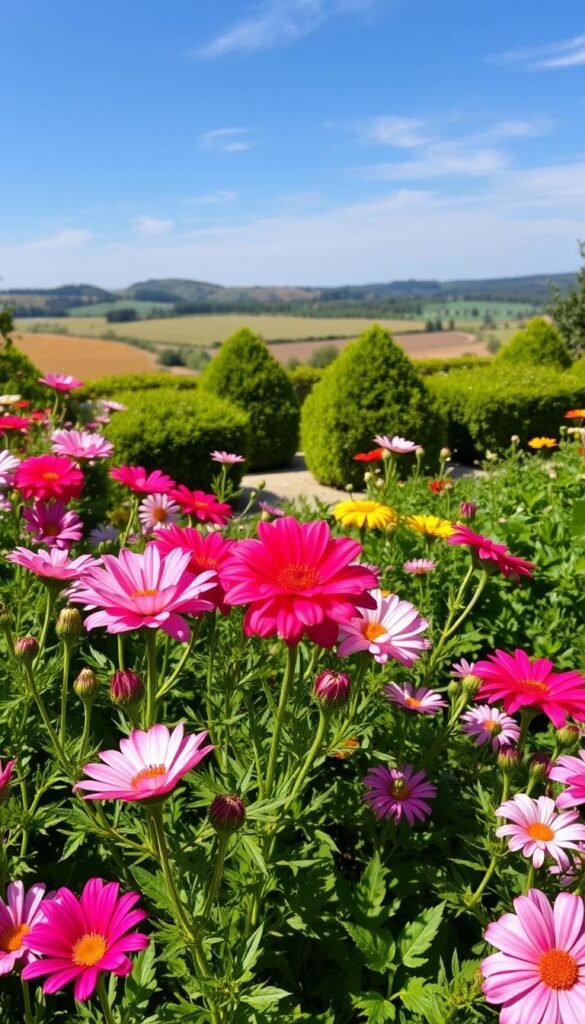
Keeping your outdoor space thriving requires smart routines that balance effort with beauty. These proven methods help your plantings stay healthy while maximizing visual impact season after season.
Watering, Fertilizing, and Regular Maintenance Tips
Deep watering twice weekly beats daily sprinkles. This approach trains roots to seek moisture deeper in the soil. Pair morning irrigation with slow-release plant food for steady growth.
Refresh mulch layers every spring to lock in moisture and block weeds. Deadheading spent blooms weekly keeps plants focused on producing new flowers rather than seeds. A quick daily walk-through lets you spot issues before they escalate.
Effective Weeding, Pruning, and Pest Control Strategies
Pull invaders after rain when roots slide out easily. Use angled tools for taprooted weeds like dandelions. Trim leggy stems by one-third using clean shears to encourage bushier growth.
Prevent aphids and mites by spacing plants for airflow. Introduce ladybugs for natural pest control. “Healthy soil grows strong plants that resist invaders naturally,” reminds horticulturist Emma Carter. Test your earth annually and amend with compost as needed.
Designing with the Main Keyword: Home Flower Garden Inspiration: Achieving Professional-Looking Results
Unlocking your yard’s full potential requires blending expert techniques with personal flair. By focusing on intentional design choices, you can create spaces that feel both curated and effortlessly inviting. Let’s explore actionable strategies to elevate your outdoor areas while keeping maintenance manageable.
Showcasing Expert Advice in a Listicle Format
Top designers share these universal tips for striking arrangements:
Group plants in threes or fives for natural-looking clusters that catch the eye. Test soil pH annually and amend with compost to boost plant health. Install temporary potted displays while permanent specimens establish roots.
Portland landscaper Jamie Chen advises: “Always consider mature plant sizes – overcrowding leads to constant pruning.” These principles work whether you’re refreshing existing beds or starting from scratch.
Using Verbatim Keyword Placement for SEO Optimization
Incorporate key phrases like “flower garden” naturally within content. Mention them in image captions showcasing your lavender border or peony collection. This helps search engines understand your page’s focus while keeping text reader-friendly.
Pair these techniques with seasonal photos and detailed alt text. Over time, your site becomes a go-to resource for aspiring growers seeking both beauty and practicality in their landscapes.

